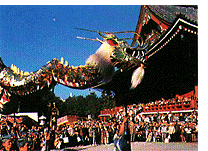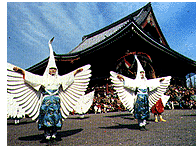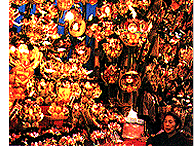|
|
Autumn Events in Asakusa |
|
|
|
|
Enjoy the four seasons in Asakusa
Some events may be canceled or postponed due to coronavirus(COVID-19) concerns.
Please check official websites for the latest updates and information. |
|
O-cha-tou-bi (Days for Acts of Merits) [September20, October19, November7] There are various special temple festivals for Buddhist deities. For example, since ancient times, the festival for the Kannon has been held on the 18th of May and the festival for the Jizo on the 24th. Additional days to perform acts of merit were established after the late Muromachi era. It was said that worshipping on one of these days brings the same benefits as worshipping for one hundred days or one thousand days, and these special days to perform acts of merit became very common all over Japan. O-cha-tou-bi is another name for this day. Following an old custom, believers drink the tea that has been first offered to the Kannon. Tea is actually offered to the Kannon every day, but only on the day for performing acts of merit are believers allowed to drink it. Believers formed an organization called the O-cha-tou-ko which is today named Gessanko and its membership now consists of more than 5000 believers. The O-cha-tou-ko at Sensoji was organized during the Tempo era (1830-1843) and the leaflets that were issued by the organizers at the time still exist today. Kiku-kuyo (Memorial Service for Chrysanthemums) [October 18, Kinryuzan Sensoji Temple Festival Day] On this day, old chrysanthemums that have been donated to the temple called gekuugiku are replaced with new ones called kengiku brought by parishioners. A service is conducted throughout the day together with a musical incantation of the Kannon sutra. For this reason, this service is also called kuge-e (Flower Donation Service). It was first held on October 11, 1897 (according to the old calendar, September 9) at the request of Okuda Kansho, the head abbot of the temple. Since the Showa era, the memorial service has been held on October 18, when chrysanthemums are in season. This memorial service is related to such happy ceremonies as the choyo-no-utage in ancient China and the kiku-no-kisewata that was later brought to Japan. These ceremonies are based on a lyric song called kikujido that tells a mythical story about the magical powers of the Kannon sutra and chrysanthemums. According to the Kikujido legend, if four lines of the sutra (four lines out of eight that praise the Kannon) are written on a chrysanthemum leaf, the dew that forms on this leaf will become an elixir that brings 800, 900 or even 1000 years of life, also giving those who drink it a youthful appearance.
Kinryu-no-mai (Golden Dragon Dance) [October 18, Kinryuzan Sensoji Temple Festival Day]  The official temple name for Sensoji Temple is Kinryuzan (Mountain of Golden Dragon) and this name comes from a tale about a golden dragon. According to the legend, 1000 pine trees suddenly appeared overnight near the temple on the 18th day. Three days later, a golden dragon measuring 100 shaku (approx. 30 m) descended into the pine trees from the heavens and was never seen again. The Golden Dragon Dance is based on this episode. It was first presented in October 1958 to celebrate the opening of Showa Hall of the temple by the Asakusa Kannon Worshippers' Association as an event to be held for many generations to come.
The official temple name for Sensoji Temple is Kinryuzan (Mountain of Golden Dragon) and this name comes from a tale about a golden dragon. According to the legend, 1000 pine trees suddenly appeared overnight near the temple on the 18th day. Three days later, a golden dragon measuring 100 shaku (approx. 30 m) descended into the pine trees from the heavens and was never seen again. The Golden Dragon Dance is based on this episode. It was first presented in October 1958 to celebrate the opening of Showa Hall of the temple by the Asakusa Kannon Worshippers' Association as an event to be held for many generations to come.
The dance is presented on October 18 at the Kiku-kuyo (Memorial Service for Chrysanthemums) and on March 18 when the temple's sacred image is unveiled for public viewing. Under the direction of the late Mantaro Kubota, the Kinryu-no-mai was produced by Yoshio Yoshikawa, scored by Yoshiaki Machida and choreographed by Tomoaki Fujima. It is performed by more than 70 male volunteers from local youth organizations who first purify themselves before devoting themselves wholeheartedly to the dance. This has made the Kinryu-no-mai a local event of widespread fame.
Tokyo Jidai-matsuri (Tokyo Historical Parade) [November 3, Culture Day] *This event has been suspended since 2014.
Tokyo has a long history: about 540 years since Dokan Ota built Edo Castle and about 400 years since Ieyasu Tokugawa's arrival in Edo. Yet Asakusa is even older, dating back 1367 years to 628 when an image of the Kannon emerged from the Sumida River and was worshipped in this area. A community developed around Sensoji Temple, and particularly during the Edo era, the temple flourished as the center of popular Edo culture. Even now, Asakusa retains the flavor of old Edo. This "downtown" area of Tokyo is popular with people in Japan and around the world. Tokyo Jidai-matsuri is an historical parade that recreates Tokyo's history and culture. It was first held on November 3, 1999 as part of the event called Tokyo Renaissance, in an attempt to publicize Asakusa's unique presence as the historical and cultural center of the international city of Tokyo as it moves into the 21st century.
Tokyo Jidai-matsuri Parade Program
Worshipping at Sensoji Temple
Theme: The Blooming Edo Culture as a Stage of Dreams
Fifteenth Shogun Yoshinobu Tokugawa The parade leaves the square behind Sensoji Temple at 1:30 p.m. and proceeds along Umamichi-dori from Nitenmon Gate, in front of Asakusa Matsuya Department Store, along Kaminarimon-dori, to Kaminarimon Gate and ends in Asakusa Tawaramachi at 3:30 p.m.
Shirasagi-no-mai (White Heron Dance) [November 3, Culture Day, Simultaneous with Tokyo Jidai-matsuri]  The Shirasagi-no-mai is mentioned in Sensoji Keian Engi Emaki, a scroll dating from 1652, which describes dancers dressed in heron costumes in a festival parade. In 1968, the Asakusa Tourist Federation revived the dance in an event to commemorate the 100th anniversary of Tokyo as the nation's capital. The Shirasagi-no-mai is a Shinto ritual that has its roots in the Gion Festival of Yasaka Shrine in Kyoto over 1000 years ago and it was performed to drive out the plague.
The Shirasagi-no-mai is mentioned in Sensoji Keian Engi Emaki, a scroll dating from 1652, which describes dancers dressed in heron costumes in a festival parade. In 1968, the Asakusa Tourist Federation revived the dance in an event to commemorate the 100th anniversary of Tokyo as the nation's capital. The Shirasagi-no-mai is a Shinto ritual that has its roots in the Gion Festival of Yasaka Shrine in Kyoto over 1000 years ago and it was performed to drive out the plague.While very popular at one time, it was discontinued and then performed again as a Shinto ritual at the Gion Festival in Yamaguchi in 1369 when Insei Ouchi took on the project of constructing Yasaka Shrine in Yamaguchi Prefecture. Then, Masayori Yoshimi of Tsuwano in Shimane Prefecture moved it again from Yamaguchi. The Shirasagi-no-mai performed at Sensoji Temple is very well-known nationwide as a re- creation of a festival procession called Keian-Engi-Henzakuyo that is based on Kyoto tradition, and thereby provides a glimpse further back into the customs of the Heian period (794-1192).
Tori-no-ichi [November 12, 24 (Rooster Fair on the Day of the Rooster)] Otori Shrine Address: 3-18-7 Senzoku, Taito-ku Deity: Amanohiwashi no Kami Yamato Takeru no Mikoto
In the Edo era, Otori Shrine was called Otori-daimyo Shrine. During this time, Shintoism and Buddhism were not clearly practiced as distinct religions and the chief priest of the adjacent Chokokuji Temple also served as caretaker and steward of the shrine. However, with the beginning of the Meiji era, the two religions were separated, the name of the shrine was changed to Otori Shrine and its precincts were clearly marked off from those of Chokokuji Temple.
Tori-no-ichi or Otori-sama (The Festival of the Rooster) The festival thrived during the mid-Edo era. In the Toto-Saijiki (The Chronicle of the East Capital) first published in 1838, it is stated that Shitaya Taho-Otori-Daimyojin (the present Otori Shrine) began to attract large crowds by the 1770's for the festival had become famous in the Horeki and Tempo periods of the mid-Edo era (1750-1760). Kikaku, a well-known haiku poet of the day, composed a haiku about the tori-no-ichi at Taho in Asakusa: "Anticipating spring, The beginning of all, Year-end fairs."
Kumade Depending on the year, there are three Days of the Rooster in November. The first Day of the Rooster in November is called ichi-no-tori (first Festival of the Rooster) and the second Day of the Rooster is called ni-no-tori (second Festival of the Rooster). In some years the third, san-no-tori (Third Festival of the Rooster) is held. For the people of Edo, worshipping at the otori-sama signaled the coming of winter and a time to start preparing for the season. |
| Source: Asakusa Tourist Federation |
|
|
Exploring Delicious Asakusa | Asakusa Map |
|
| |||||
| Back to Menu | |||||
 According to Japanese mythology, the world turned dark when the sun god, Amaterasu Omikami, hid in a cave. Amenouzume no Mikoto performed a dance to lure her out. Another god, Amenotajikara no Mikoto opened the door to the cave as his son, Amenohiwashi no Mikoto, played a stringed instrument called the gen.
According to Japanese mythology, the world turned dark when the sun god, Amaterasu Omikami, hid in a cave. Amenouzume no Mikoto performed a dance to lure her out. Another god, Amenotajikara no Mikoto opened the door to the cave as his son, Amenohiwashi no Mikoto, played a stringed instrument called the gen.